Remora
The remoras /ˈrɛmərəz/, sometimes called suckerfish, are a family (Echeneidae) of ray-finned fish in the order Carangiformes.[4] Depending on species, they grow to 30–110 cm (12–43 in) long. Their distinctive first dorsal fins take the form of a modified oval, sucker-like organ with slat-like structures that open and close to create suction and take a firm hold against the skin of larger marine animals.[5] The disk is made up of stout, flexible membranes that can be raised and lowered to generate suction.[6] By sliding backward, the remora can increase the suction, or it can release itself by swimming forward. Remoras sometimes attach to small boats, and have been observed attaching to divers as well. They swim well on their own, with a sinuous, or curved, motion.
| Remora | |
|---|---|
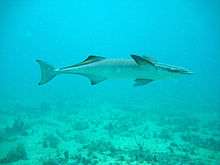 | |
| Common remora, Remora remora | |
| Scientific classification | |
| Kingdom: | Animalia |
| Phylum: | Chordata |
| Class: | Actinopterygii |
| Order: | Carangiformes |
| Family: | Echeneidae Rafinesque, 1810[2] |
| Genera[3] | |
| |
| Synonyms | |
|
Echeneididae | |
Characteristics
Remora front dorsal fins have evolved to enable them to adhere by suction to smooth surfaces and they spend their lives clinging to a host animal such as a whale, turtle, shark or ray. It is probably a mutualistic arrangement as the remora can move around on the host, removing ectoparasites and loose flakes of skin, while benefiting from the protection provided by the host and the constant flow of water across its gills.[7] Although it was initially believed that remoras fed off particulate matter from the host's meals, this has been shown to be false; in reality, their diets are composed primarily of host feces.[8]
Habitat
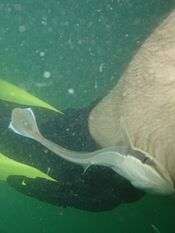
Remoras are tropical open-ocean dwellers, but are occasionally found in temperate or coastal waters if they have attached to large fish that have wandered into these areas. In the mid-Atlantic Ocean, spawning usually takes place in June and July; in the Mediterranean Sea, it occurs in August and September. The sucking disc begins to show when the young fish are about 1 cm (0.4 in) long. When the remora reaches about 3 cm (1.2 in), the disc is fully formed and the remora can then attach to other animals. The remora's lower jaw projects beyond the upper, and the animal lacks a swim bladder.[9]
Some remoras associate with specific host species. They are commonly found attached to sharks, manta rays, whales, turtles, and dugongs, hence the common names "sharksucker" and "whalesucker". Smaller remoras also fasten onto fish such as tuna and swordfish, and some small remoras travel in the mouths or gills of large manta rays, ocean sunfish, swordfish and sailfish.
The relationship between a remora and its host is most often taken to be one of commensalism, specifically phoresy.
Physiology
Research into the physiology of the remora has been of significant benefit to the understanding of ventilation costs in fish.
Remoras, like many other fishes, have two different modes of ventilation. Ram ventilation[10] is the process in which at higher speeds, the remora uses the force of the water moving past it to create movement of fluid in the gills. Alternatively, at lower speeds the remora will use a form of active ventilation,[10] in which the fish actively moves fluid through its gills. In order to use active ventilation, a fish must actively use energy to move the fluid; however, determining this energy cost is normally complicated due to the movement of the fish when using either method. As a result, the remora has proved invaluable in finding this cost difference (since they will stick to a shark or tube, and hence remain stationary despite the movement or lack thereof of water). Experimental data from studies on remora found that the associated cost for active ventilation created a 3.7–5.1% increased energy consumption in order to maintain the same quantity of fluid flow the fish obtained by using ram ventilation.[11]
Other research into the remora's physiology came about as a result of studies across multiple taxa, or using the remora as an out-group for certain evolutionary studies. Concerning the latter case, remoras were used as an outgroup when investigating tetrodotoxin resistance in remoras, pufferfish, and related species, finding remoras (specifically Echeneis naucrates) had a resistance of 6.1–5.5×10−8 M.[12]
Use for fishing
Some cultures use remoras to catch turtles. A cord or rope is fastened to the remora's tail, and when a turtle is sighted, the fish is released from the boat; it usually heads directly for the turtle and fastens itself to the turtle's shell, and then both remora and turtle are hauled in. Smaller turtles can be pulled completely into the boat by this method, while larger ones are hauled within harpooning range. This practice has been reported throughout the Indian Ocean, especially from eastern Africa near Zanzibar and Mozambique,[13] and from northern Australia near Cape York and Torres Strait.[14][15]
Similar reports come from Japan and from the Americas. Some of the first records of the "fishing fish" in the Western literature come from the accounts of the second voyage of Christopher Columbus. However, Leo Wiener considers the Columbus accounts to be apocryphal: what was taken for accounts of the Americas may have been, in fact, notes Columbus derived from accounts of the East Indies, his desired destination.[16]
Mythology
In ancient times, the remora was believed to stop a ship from sailing. In Latin, remora means "delay", while the genus name Echeneis comes from Greek εχειν, echein ("to hold") and ναυς, naus ("a ship"). In a notable account by Pliny the Elder, the remora is blamed for the defeat of Mark Antony at the Battle of Actium and, indirectly, for the death of Caligula.[17] A modern version of the story is given by Jorge Luis Borges in Book of Imaginary Beings (1957).
Gallery
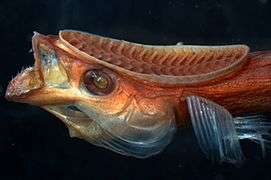
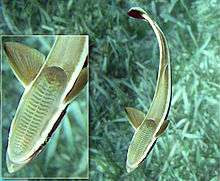 Live sharksucker, Echeneis naucrates
Live sharksucker, Echeneis naucrates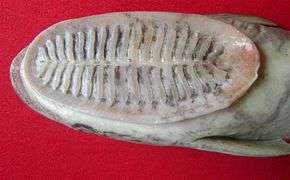 Common remora, Remora remora
Common remora, Remora remora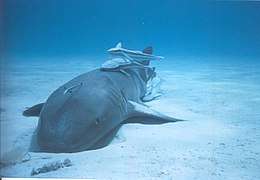 Nurse shark with remoras attending
Nurse shark with remoras attending
Timeline

See also
References
- Friedman, Matt, et al. "An early fossil remora (Echeneoidea) reveals the evolutionary assembly of the adhesion disc." Proc. R. Soc. B 280.1766 (2013): 20131200.
- Richard van der Laan; William N. Eschmeyer & Ronald Fricke (2014). "Family-group names of Recent fishes". Zootaxa. 3882 (2): 001–230. doi:10.11646/zootaxa.3882.1.1. PMID 25543675.
- Eschmeyer, W. N.; R. Fricke & R. van der Laan (eds.). "Echeneidae genera". Catalog of Fishes. California Academy of Sciences. Retrieved 16 November 2019.
- J. S. Nelson; T. C. Grande; M. V. H. Wilson (2016). Fishes of the World (5th ed.). Wiley. p. 384. ISBN 978-1-118-34233-6.
- "Sharksucker fish's strange disc explained". Natural History Museum. 28 January 2013. Archived from the original on 1 February 2013. Retrieved 5 February 2013.
- Beer, Amy-Jane. Derek Hall. (2012). The Illustrated World Encyclopedia of Marine Fish & Sea Creatures. Leicestershire: Lorenz Books. p. 235. ISBN 978-0-7548-2290-5.
- Jackson, John (30 November 2012). "How does the Remora develop its sucker?". National History Museum. Retrieved 2 January 2016.
- Williams, E. H.; Mignucci-Giannoni, A. A.; Bunkley-Williams, L.; Bonde, R. K.; Self-Sullivan, C.; Preen, A.; Cockcroft, V. G. (2003). "Echeneid-sirenian associations, with information on sharksucker diet". Journal of Fish Biology. 63 (5): 1176. CiteSeerX 10.1.1.619.4020. doi:10.1046/j.1095-8649.2003.00236.x.
- Froese, Rainer, and Daniel Pauly, eds. (2019). "Echeneididae" in FishBase. August 2019 version.
- Willmer, Pat; Stone, Graham; Johnston, Ian (2009-03-12). Environmental Physiology of Animals. John Wiley & Sons. ISBN 9781444309225.
- Steffensen, J. F.; Lomholt, J. P. (1983-03-01). "Energetic cost of active branchial ventilation in the sharksucker, Echeneis naucrates". Journal of Experimental Biology. 103 (1): 185–192. ISSN 0022-0949. PMID 6854201.
- Kidokoro, Yoshiaki; Grinnell, Alan D.; Eaton, Douglas C. (1974). "Tetrodotoxin sensitivity of muscle action potentials in pufferfishes and related fishes". Journal of Comparative Physiology. 89: 59–72. doi:10.1007/BF00696163.
- Gudger, E. W. (1919). "On the Use of the Sucking-Fish for Catching Fish and Turtles: Studies in Echeneis or Remora, II., Part 1". The American Naturalist. 53 (627): 289–311. doi:10.1086/279716. JSTOR 2455925.
- Gudger, E. W. (1919). "On the Use of the Sucking-Fish for Catching Fish and Turtles: Studies in Echeneis or Remora, II., Part 2". The American Naturalist. 53 (628): 446–467. doi:10.1086/279724. JSTOR 2456185.
- MacGillivray, John (1852). Narrative of the Voyage of H.M.S. Rattlesnake, Commanded By the Late Captain Owen Stanley, R.N., F.R.S. etc. During the Years 1846–1850. 2. London: Lords Commissioners of the Admiralty. (Dr. Gudger's accounts are more authoritative, but this source is noted as an early account that Gudger appears to have missed.)
- Wiener, Leo (1921). "Once more the sucking-fish". The American Naturalist. 55 (637): 165–174. doi:10.1086/279802. JSTOR 2456418.
- Pliny the Elder. "Book 32, Chapter 1". Natural History. (cited in Gudger, E. W. (1930). "Some old time figures of the shipholder, Echeneis or Remora, holding the ship". Isis. 13 (2): 340–352. doi:10.1086/346461. JSTOR 224651.)
External links
| Wikimedia Commons has media related to Echeneidae. |